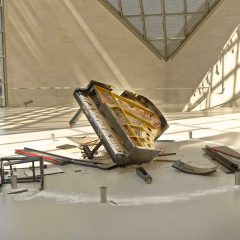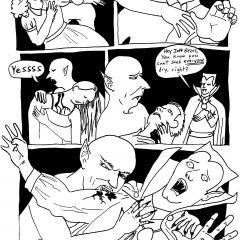[Our U.K. correspondent Katie keeps an eye out for Alex Chinneck’s latest architectural art pieces, and reviews one piece that is taking longer than expected to resolve itself. — the Artblog editors]
If you notice a building doing something strange in the streets of the U.K., there’s a good chance that Alex Chinneck is somehow involved. Twitter is full of exclamations from Londoners who had walked past “Under the Weather But Over the Moon” a thousand times before noticing that the building was upside-down; his other architectural creations slide off the face of houses and hover in mid-air. These large-scale projects are perhaps thanks to his tendency to identify more with the world of construction than with art school. “The trouble is,” he told the Telegraph, “I’m not just interested in art or sculpture, but architecture, engineering, construction, theatre, set design, and magic.”
Engineering entropy
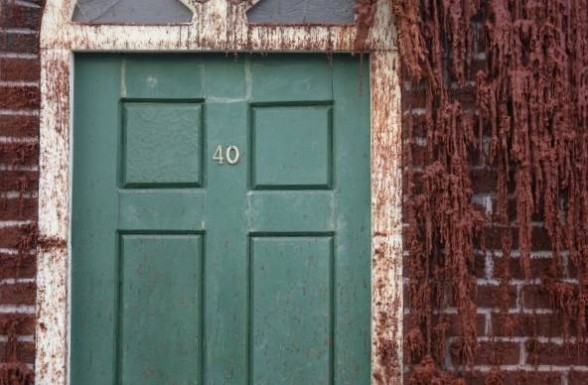
It is magic that he creates, an upending of reality as familiar objects behave in ways that, despite their absurdity, make a strange kind of sense. His latest work, “A Pound of Flesh for 50p,” is a beautifully constructed, full-sized house made entirely of individually-cast wax bricks that are slowly melting away.
Writeups refer to the history of a candle factory on the same road, but this narrative almost feels like an afterthought; the interest of this work is in making something that looks like a brick, builds like a brick, but after a while does not survive like a brick. Chinneck loves to play with the materiality of a building, allowing it to lose its usual solidity in ways impossible without the careful construction of his theatrical stunts.
But just as a magician’s tricks require huge amounts of planning, these works conceal the process that allows the illusion to succeed. He describes his role in these huge constructions as more of a project manager than anything else, engaged in the planning and paperwork involved in realising such ridiculous objects. It is interesting, then, that the timeline of the melting house did not go quite as intended. Chinneck’s own sketches had the house ending up as a messy wax puddle, but when I visited on the second-to-last day of its planned month-long stay on Southwark Street, London, I found a building still standing a good storey-and-a-half tall.
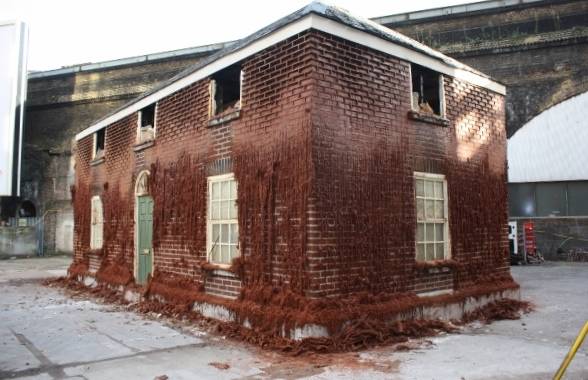
It was a surprise, especially as even the melting had been carefully, industriously planned. For three hours every morning, “[the team went] there with industrial blowers running off generators, heating the top course of brick so it melts from the top down,” as shown in the maquettes Chinneck made of a 6-foot wall that ended in a red, visceral puddle.
Added meaning in titles
Seeing the state that the melted bricks were intended to attain gives a fleshy insight into the rather cryptic title, a reference to Shylock’s demand in The Merchant of Venice for a pound of flesh as security for a loan. In the context of the current financial climate, it suggests the world of mortgages and lending, financial extraction from the very poor by the very rich, and the devaluing of those extractions–a pound, now worth only a measly 50p.
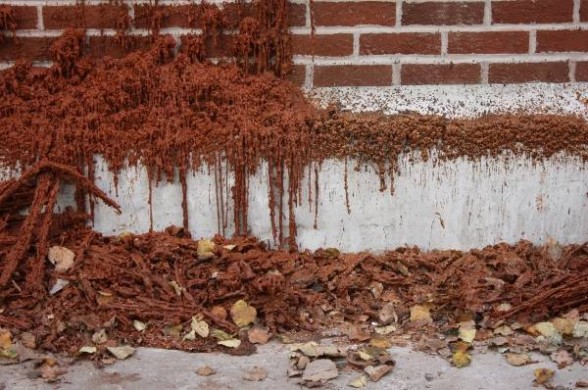
It’s a nastier and heavier title than is Chinneck’s habit. In a fascinating interview with Sculpturevox, Chinneck says, “The realization of these projects is enormously administrational…The titles are my last place for a bit of abstraction or poetry, just a bit of Bohemian indulgence…I like the rhythm of words and the use of alliteration. With ‘From the Knees of My Nose to the Belly of My Toes,’ I was thinking of this idea of distortion: an architectural distortion of a building doing a sit-up and swapping the windows and doors for body parts.
“There are always two titles: there’s the working title, which often equates to the media title, then there’s the official, correct, title.” ‘From the Knees of My Nose to the Belly of My Toes’ is known as the sliding house; the floating building in Covent Garden is actually titled ‘Take My Lightning But Don’t Steal My Thunder.'” Just as he embraces rather than laments the planning of such projects, Chinneck is very much tuned in to the public perception of his works, the double-take by the person passing on the street.
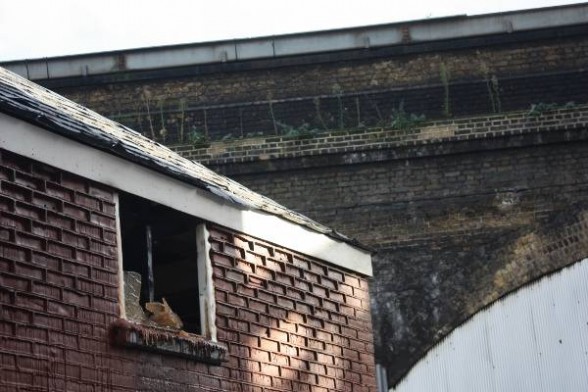
These works play lightness and weight off against one another. The idea is quick and simple, the experience of the observer fast and funny, but the route between the two is incredibly weighty and turgid. It was Chinneck gazing idly at a row of smashed windows that gave rise to one of his most remarkable works, “Telling the Truth through False Teeth,” in which he replaced each of the windows of a large building in Hackney with 312 identically-smashed panes of glass; the concept could not be more concise, but the mind boggles at the labour-intensive process involved in realising it.
Having taken on the role of administrator of the unexpected, perhaps Chinneck deserves to have his own work surprise him from time to time. The melting house has been granted a few more weeks in which to liquefy, something of an an unintended punchline; after all, what large-scale construction project ever delivers quite on time? Its unwillingness to melt away is also a reminder of the astonishing structural integrity of the architecture that frames our lives, making it all the more remarkable that Chinneck’s tricks can make us forget, even for a hallucinatory moment, how solid these structures really are.
Alex Chinneck’s “A Pound of Flesh for 50p,” a part of London’s Merge Festival, will remain on view for a few more weeks at 40 Southwark St., SE 9HP.



